When I pull into my driveway, the first thing I notice is the front yard. It’s the space that welcomes me home after a long day and the place where I can let my creativity shine. There’s just something special about having a beautiful flower bed in the front—it feels like rolling out a bright, joyful welcome mat for everyone who passes by.
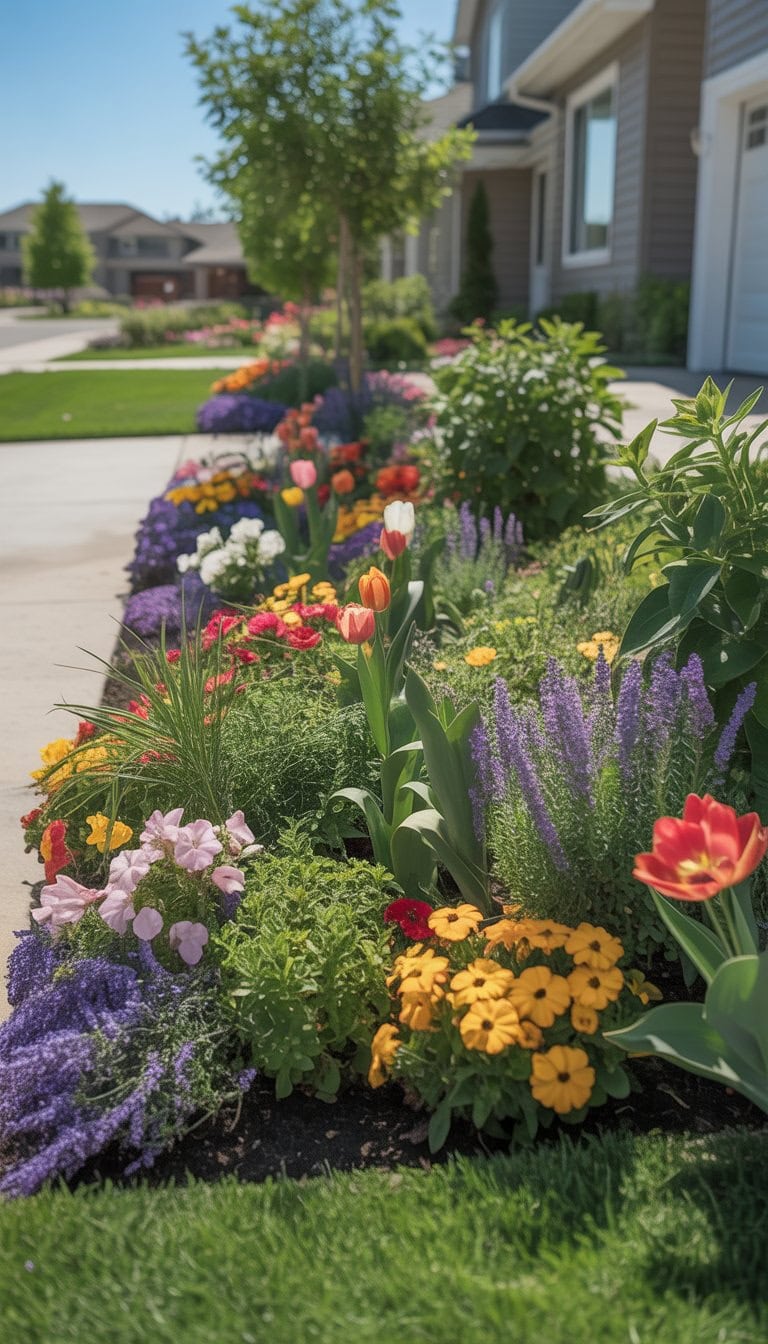
Brightening up my home with a stunning front flower bed is one of the easiest ways to boost curb appeal and make my outdoor space feel inviting and alive. Sometimes, I look for fresh ideas and a little bit of inspiration to spark a new project. That’s why I gathered these inviting and creative ways to transform any front yard into a cheerful, head-turning garden. Whether my space is big or small, I know that a little imagination and thoughtful planning can make my home stand out on my block and fill me with pride every time I step outside.
Raised flower beds with natural stone borders
I love using natural stone for raised flower beds. The stones add a classic look and blend well with almost any garden style.
When I build these borders, I usually stack flat stones or place them in layers. This gives the flower bed some height and helps keep the soil in place.
It feels great to work with real stone because every piece is different. Some stones are smooth, while others are rough, and the shapes vary.
If you want ideas, there are plenty of raised flower beds with stone to inspire your next project. Stone borders are sturdy and last for years, which makes them perfect for busy gardeners like me.
Planting Russian sage for low-maintenance color
When I want easy color for a front flower bed, I often choose Russian sage. This plant brings soft purple blooms and silvery foliage that looks good for months.
Russian sage doesn’t need a lot of water or rich soil. I just pick a sunny spot with well-draining ground and let it grow.
I love how it handles heat and dry spells without much help from me. Its upright shape fills space and mixes well with other perennials or ground covers.
To keep things neat, I trim the stems back to about 6 inches when I see new sprouts in spring. It’s a simple way to get a bushier plant and more color in my yard. Russian sage also works great for mixed borders or as a ground cover.
Mixing lavender and catmint for a calming scent
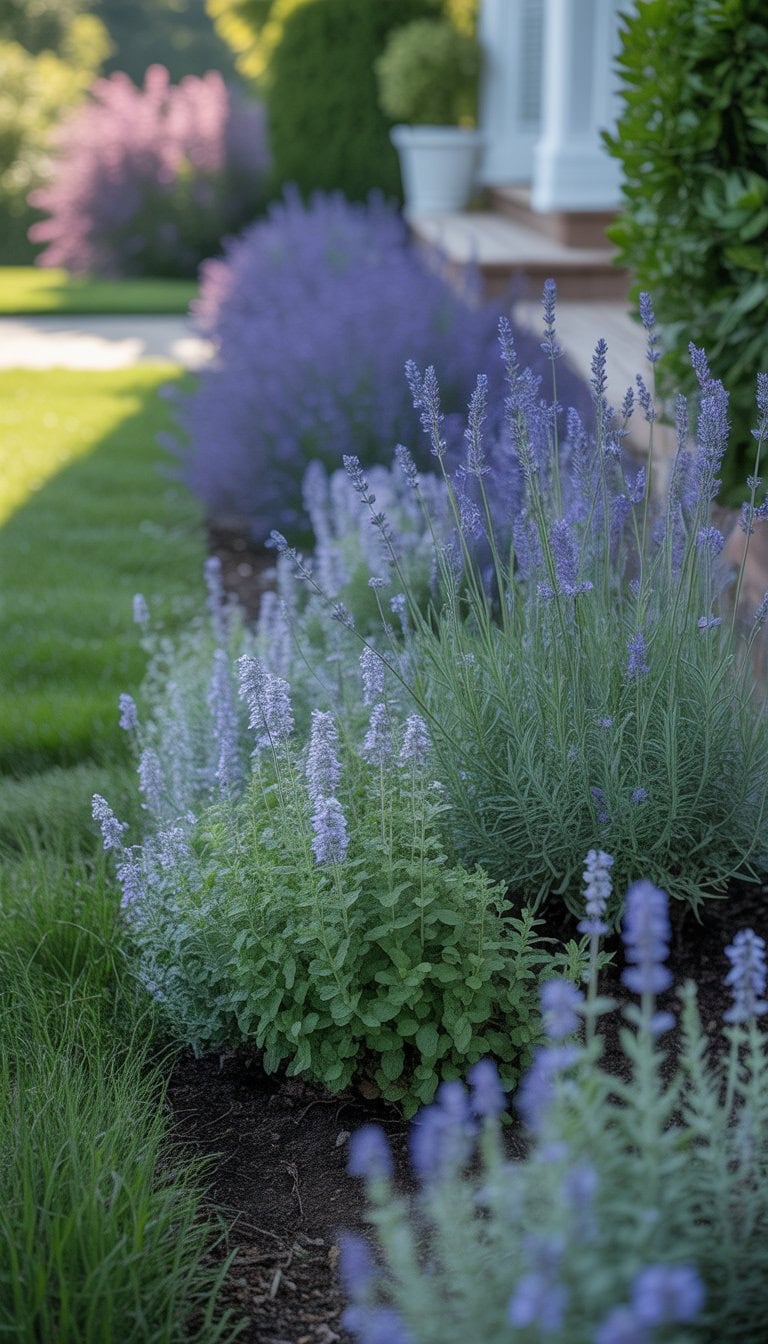
I love planting lavender and catmint together near my front walkway. Both have soft, silvery leaves and purple blooms, so they look beautiful side by side. The mix draws bees and butterflies, too.
Lavender gives off a relaxing, fresh scent that I notice every time I pass by. Catmint smells more subtle but still adds to the peaceful feeling.
Neither plant needs much water once they are settled in. Both will keep blooming through the summer, making my flower bed cheerful for months. If you want a low-maintenance garden that smells great, this pairing is a simple choice.
To see how pretty this mix can look, check out this example of lavender, catmint, and salvia planted together.
Using quick-fire hydrangeas as a centerpiece
When I plan out my front flower beds, I love using Quick Fire hydrangeas as the main focal point. Their large blooms show up early, often in late May or early June, and keep things looking fresh all season.
I find the flowers change color as summer goes on, starting white and turning pink or red as fall comes. This gives my garden a new look without extra work.
I like to plant my hydrangeas in the middle or near walkways for lots of impact. Keeping them spaced about three to four feet apart helps each plant stand out and stay healthy. For more tips and inspiration, I often check out these ideas for using Quick Fire hydrangeas.
Adding white spirea for crisp greenery
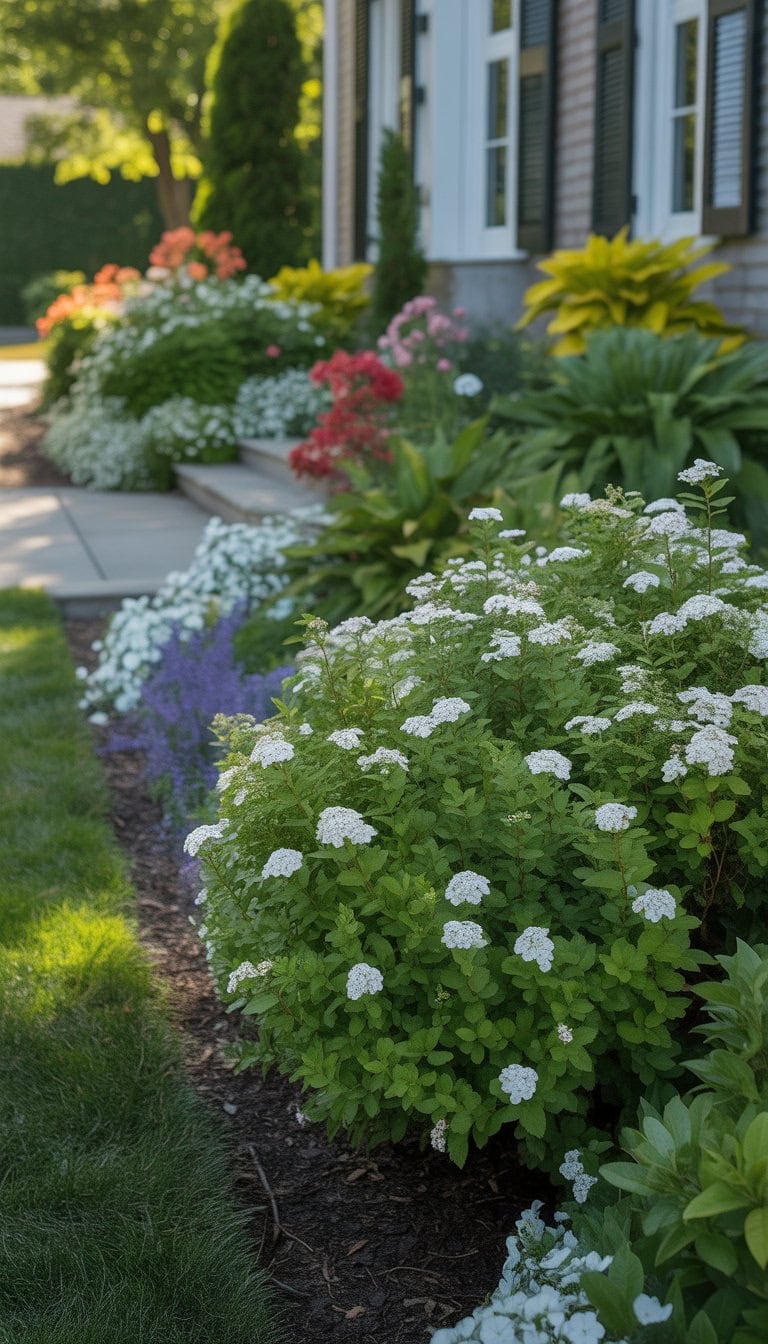
When I want my front flower bed to feel fresh and bright, I add white spirea. The small white blooms look clean and cheerful against green leaves. I like how the flowers grow in sprays and gently soften the edges of my garden.
The foliage stays lively all summer. In fall, it adds a bit of extra color as the leaves change. I also find spirea easy to trim and shape, so it fits my favorite border designs.
White spirea works well with other bushes and perennial flowers. It helps the garden look full, not too crowded or messy. For more design and care tips, I check out guides about spirea shrubs in the garden.
Incorporating wine and rose hydrangeas for hues
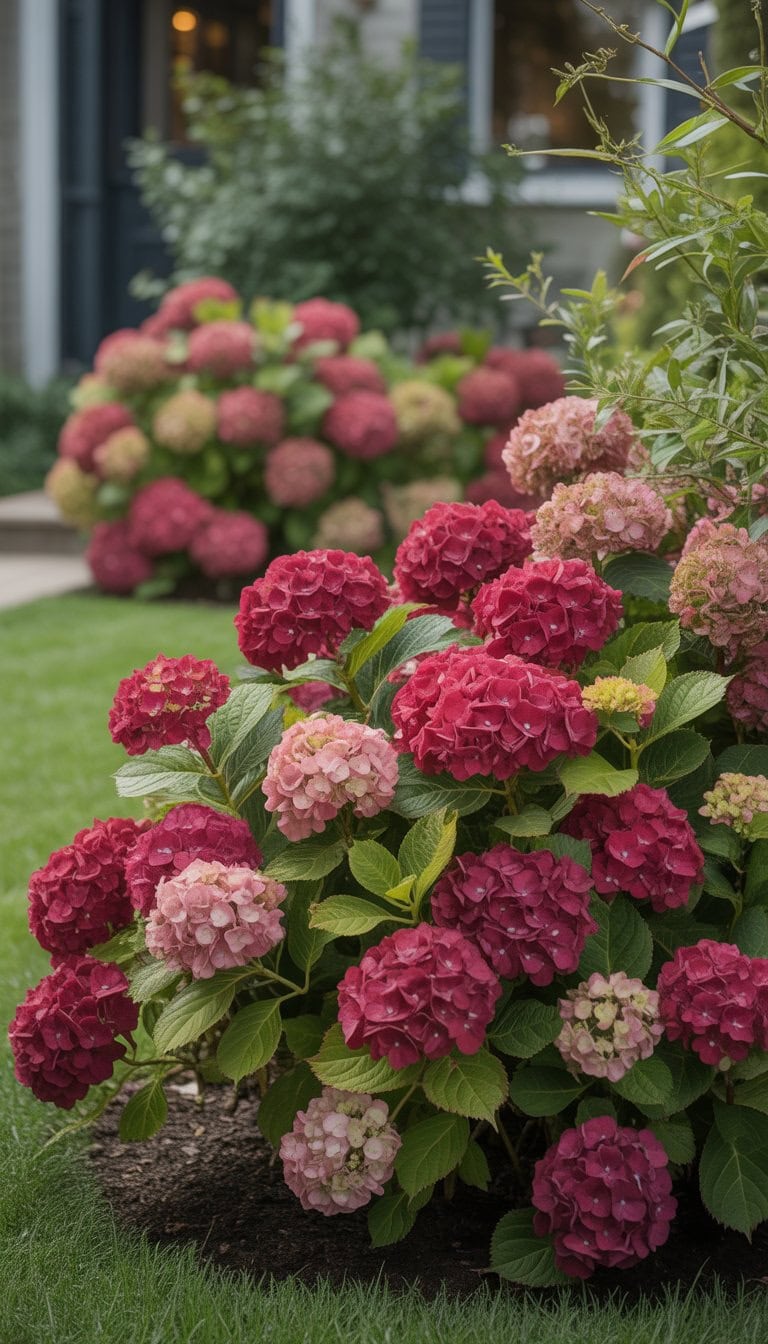
When I want my front flower bed to feel special, I always think about adding wine and rose hydrangeas. Their deep pink and red tones give the garden a warm and welcoming look. These blooms stand out against green leaves and help other plants shine.
I like to mix wine and rose hydrangeas with softer flowers so the colors do not feel too bold. Planting them in clusters brings a lush, full look to the space.
If I need inspiration or layout tips, I often browse ideas for landscaping with hydrangeas in front of the house to see how others use these colors.
Creating clusters of sedum for texture
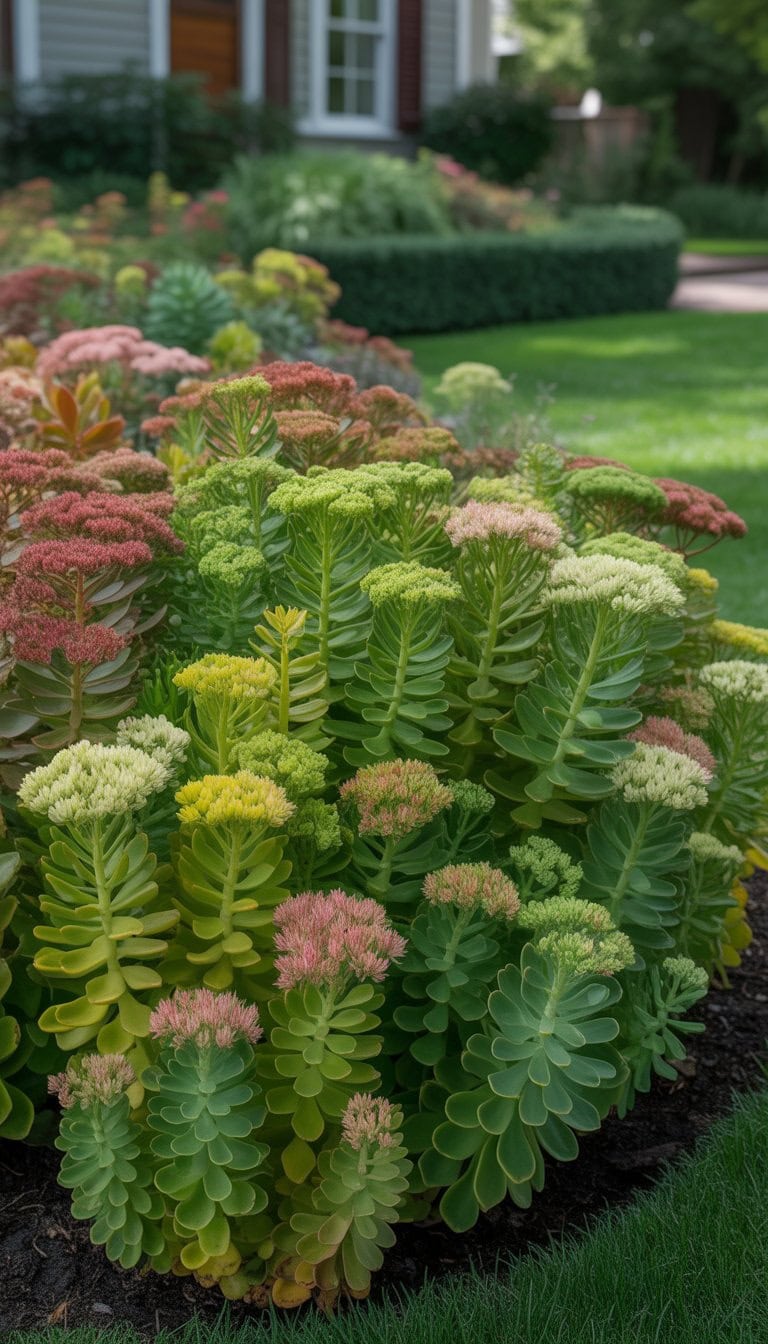
I love planting sedum in my front flower beds because they add such interesting shapes and colors. The thick, fleshy leaves stand out against softer plants and bring texture right to the front of my garden.
I like to group several sedum varieties together to create small, eye-catching clusters. Choosing types with different leaf colors, like purple and green, makes each group pop.
Sedum is also great because it’s easy to care for and can handle heat and dry spells. Some, like the ‘Purple Emperor,’ even grow lovely pink flowers in summer, adding even more detail to my landscape. For more ideas on using different sedum types, check out these sedum plant tips.
Scattering phlox among rocks for interest
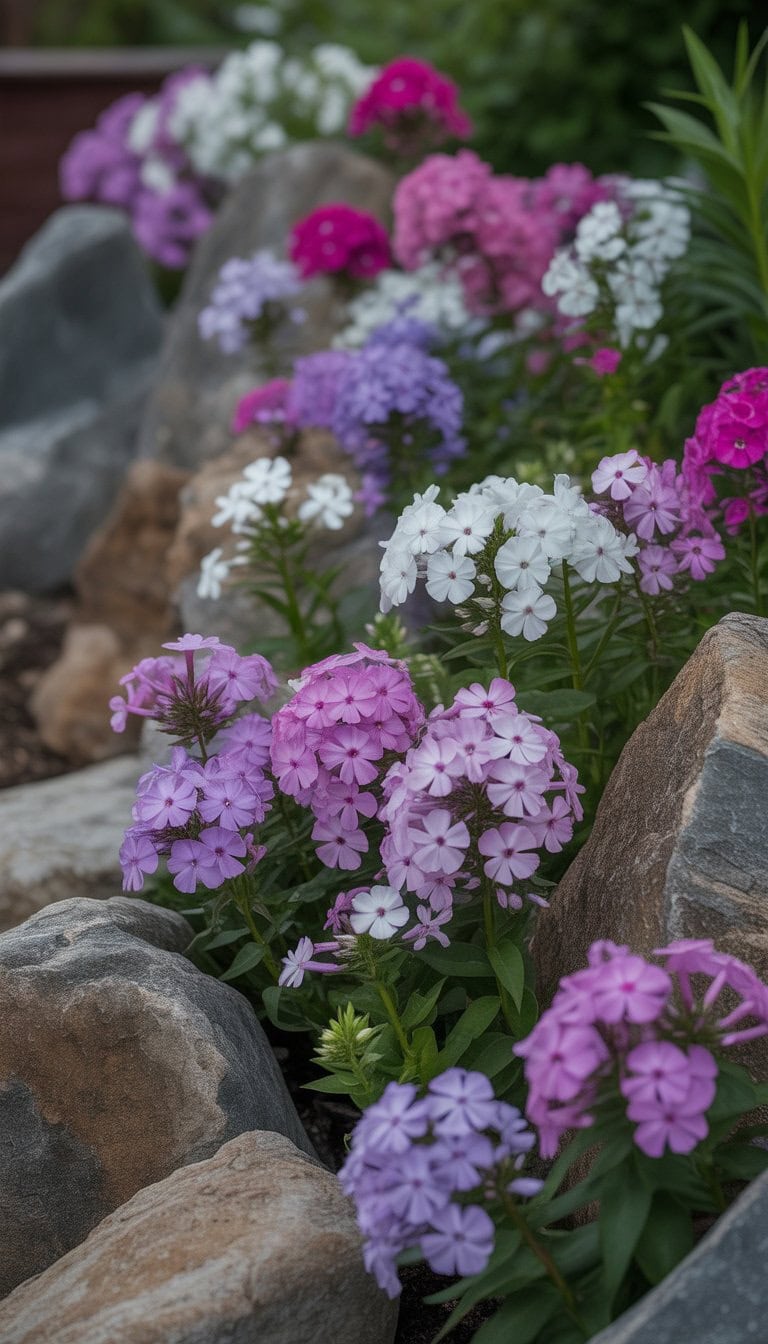
I love adding creeping phlox among rocks in my front flower bed. The way the blooms spill over stones catches my eye every spring. The pinks, purples, and whites bring lovely pops of color to the garden.
Creeping phlox thrives in spots where the soil drains quickly. That makes it a natural fit for rock gardens or rocky landscaping areas. I’ve found that the plants fill in well, making the space look full and lively.
It’s easy to tuck small clumps into spaces between rocks. I enjoy seeing phlox grow and spread, turning what was once plain stone into a cheerful carpet of flowers. For more ideas on using creeping phlox with rocks, check out this rock garden guide.
Growing lantanas for fast, vibrant blooms
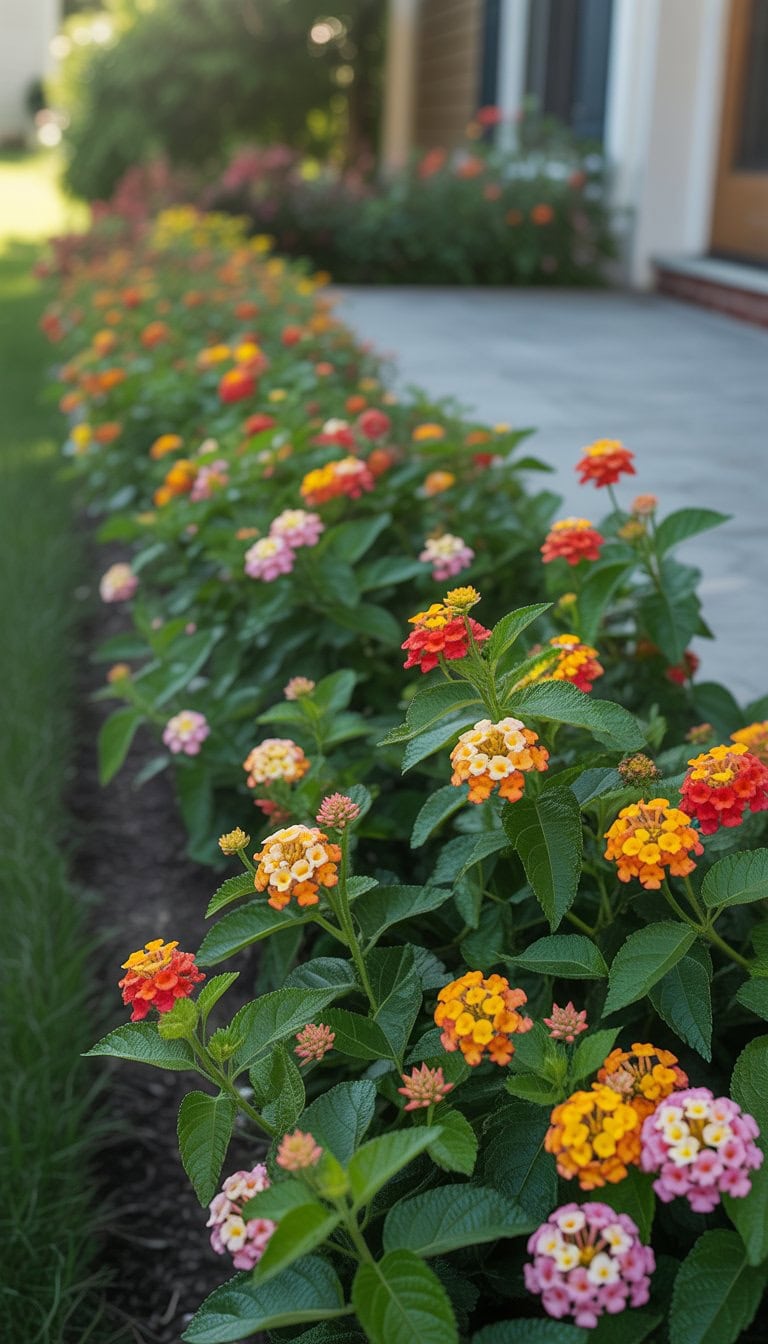
When I want a flower bed that looks cheerful all summer, I plant lantanas. These flowers bloom almost nonstop and come in bright colors like yellow, pink, and orange.
I’ve found that lantanas love full sun. I always pick a spot with at least six hours of direct light for the best results. Lantanas even seem to thrive in the hottest parts of my yard.
I give them room to grow since lantanas can spread out. Watering is simple, and I only need to water when the soil dries out. They also attract pollinators, which keeps my garden buzzing with life.
If you want easy care and quick color, lantanas are a solid choice.
Tucking in small shrubs for structure
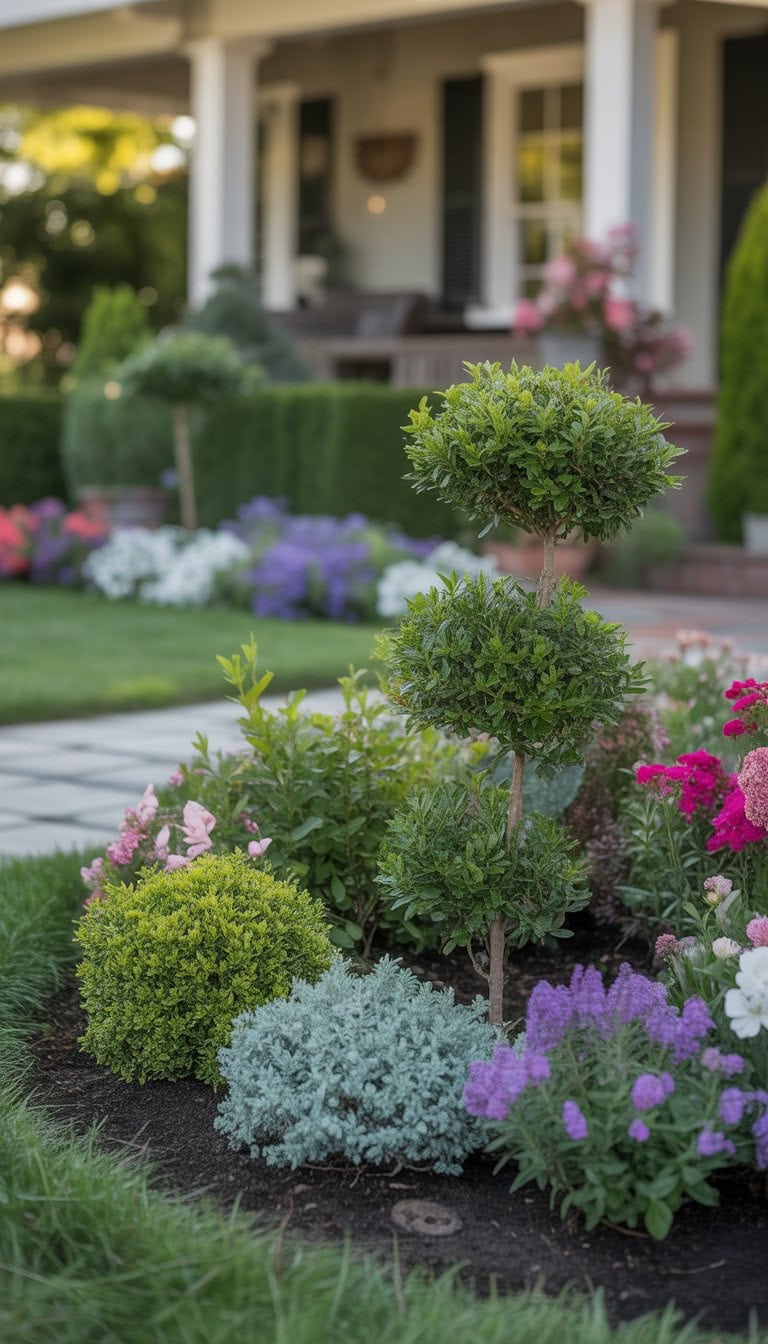
I like to add small shrubs to my front flower beds because they bring shape and order to the area. Even in tight spaces, a tidy shrub can make everything look neat without taking up much room. I see a big difference in how my beds look when I tuck in a few healthy plants.
Some of my favorites are dwarf boxwoods and small hydrangeas. These kinds of shrubs fit easily between flowers and help anchor the design. They’re also easy to trim if they start to get too big.
If you’re looking for ideas, there are lots of great options for compact shrubs that work well in small spaces. You don’t have to settle for plain beds when a few little shrubs can add interest and year-round structure.
Installing a trellis with climbing roses
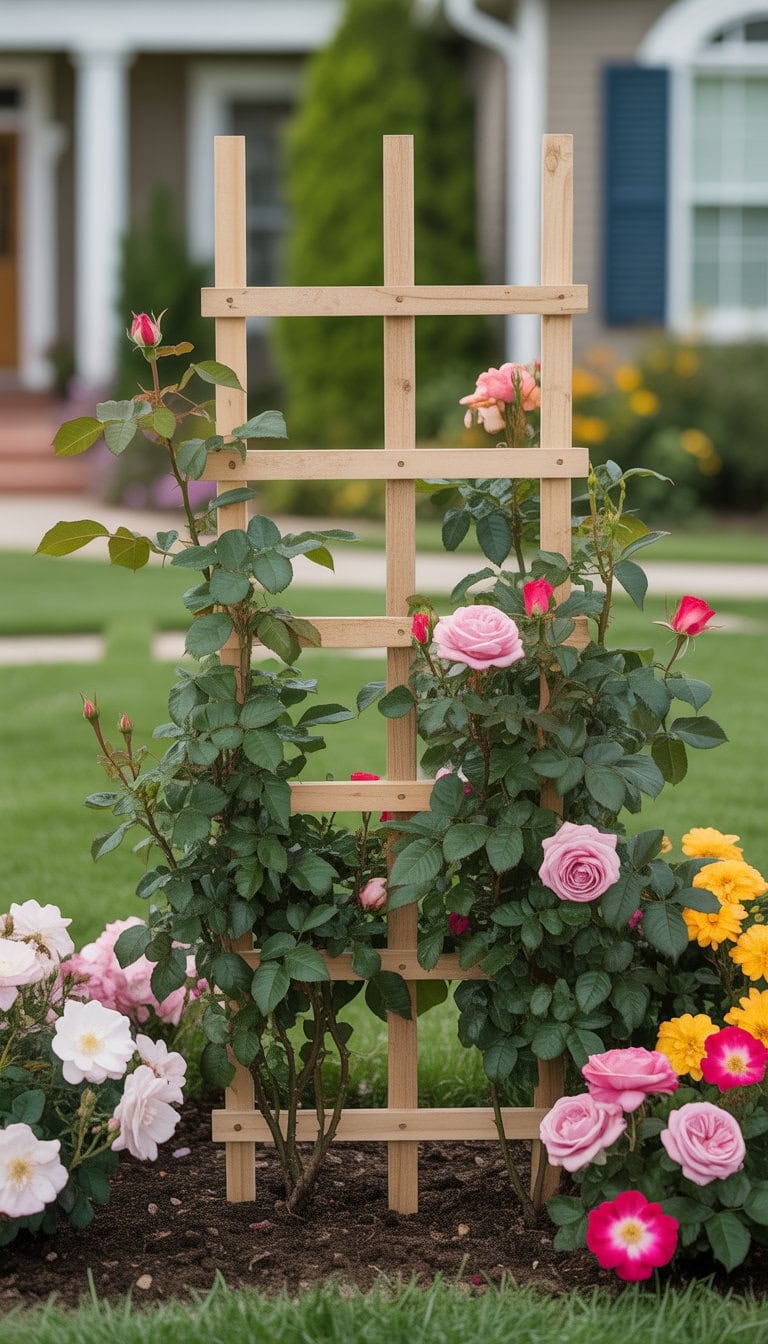
I love adding a trellis to my front flower bed. It gives vertical interest and lets me grow climbing roses, which always catch people’s eyes.
Setting up a trellis is pretty simple. I choose a sturdy spot and make sure it’s secure. Wood, metal, or vinyl are all great options depending on the look I want.
For planting, I pick healthy climbing roses. I tie the canes gently as they grow, training them up the structure. These roses will fill the space with color and fragrance.
If you want some tips, there are step-by-step guides for building a rose trellis on Pinterest, and helpful videos on attaching climbing roses to a support on YouTube.
Planting perennial bulbs for seasonal bursts
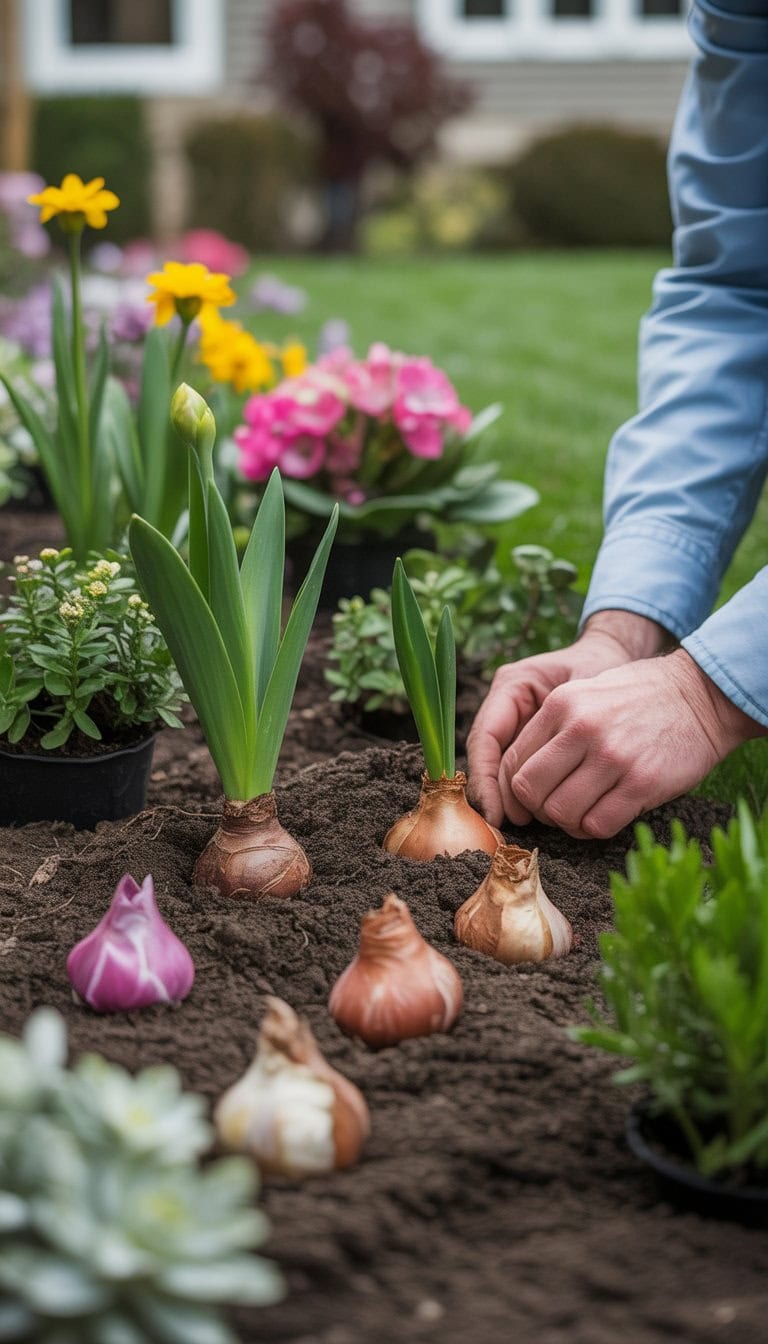
I love adding perennial bulbs to my front flower beds because they give bursts of color at different times. When spring comes, I get to see the first pops of tulips or daffodils. A few weeks later, alliums or hyacinths start to bloom.
By choosing a mix of bulbs that bloom in early, mid, and late spring, I can keep the show going for months. In summer, my perennials fill in the space after the bulbs fade. This makes the bed look full and lively.
I often tuck bulbs between established plants and around the edge. Using this approach creates a natural, layered look that comes back every year. For more tips, I sometimes check out planting advice at Gardens Illustrated.
Using tropical hibiscus for instant curb appeal
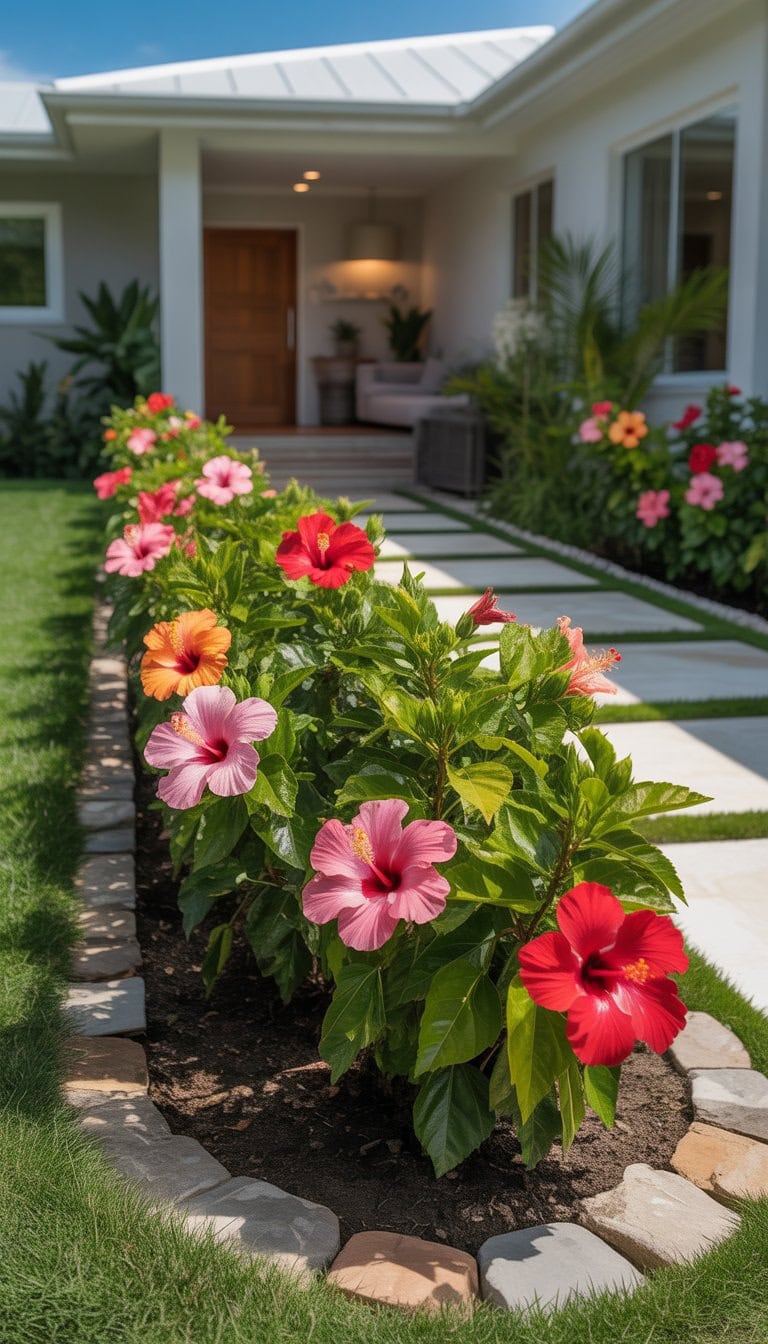
When I want bright colors in my front flower bed, I always pick tropical hibiscus. These plants have big, eye-catching blooms that come in red, yellow, pink, and orange. They create a cheerful spot that grabs attention right away.
I like planting them near the entryway where everyone can see the flowers up close. Hibiscus adds a tropical look, which makes my yard feel fresh and lively.
It’s easy to mix hibiscus with other fast-growing plants for maximum impact. The flowers bloom all season long, so my front yard stays colorful. For more ways to use these flowers, I find helpful ideas in landscaping tips with hibiscus.
Combining canna lilies with colorful foliage
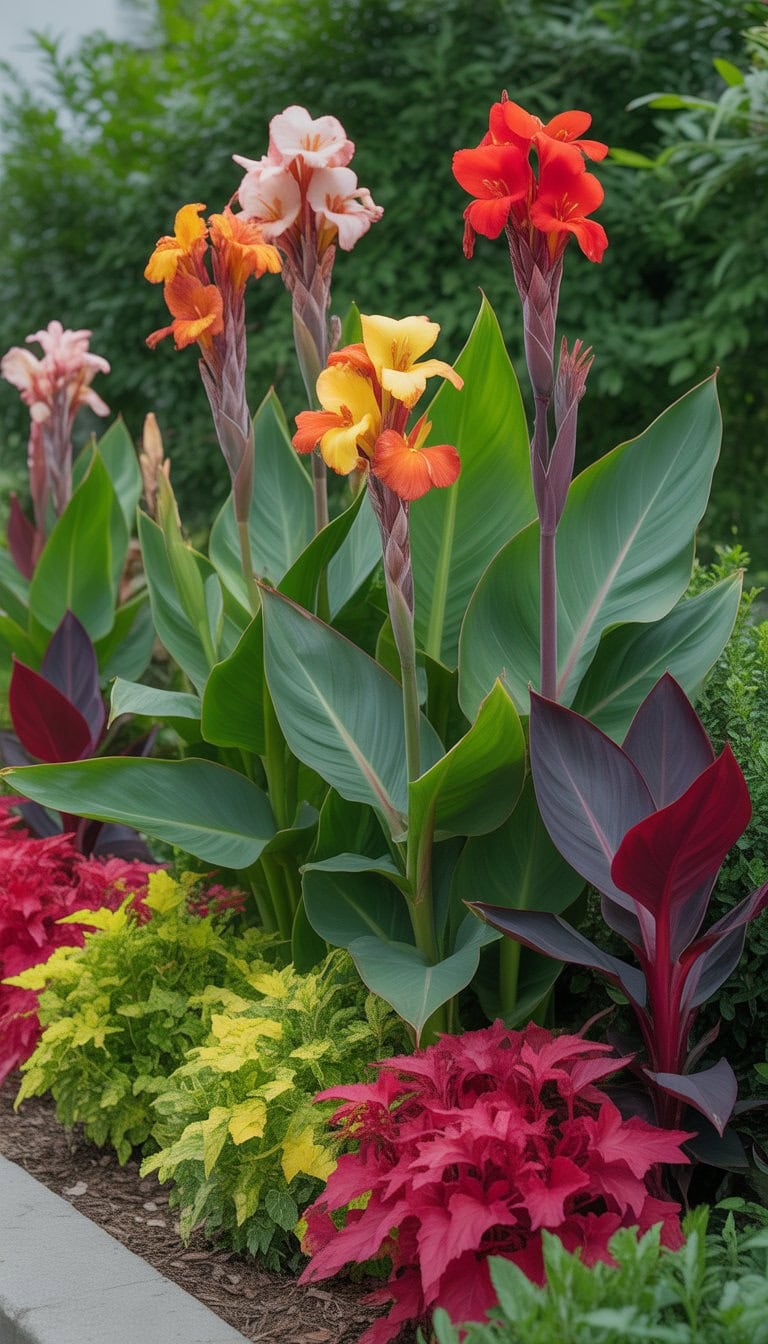
When I plant canna lilies in my front flower bed, I love to match them with colorful foliage. Their bold, tropical leaves look great next to plants with purple, red, or variegated leaves. This mix makes the bed vibrant even before the flowers bloom.
I find that coleus and caladium are perfect partners. Their wide range of leaf colors helps highlight the canna lilies’ beauty. Sometimes, I add small green plants to create contrast and balance.
Choosing annuals or perennials that match or complement the canna lily leaf color can make the display stand out. For more inspiration and ideas, I like to check out canna lily flower bed ideas.
Starting plants from seed for cost-effectiveness
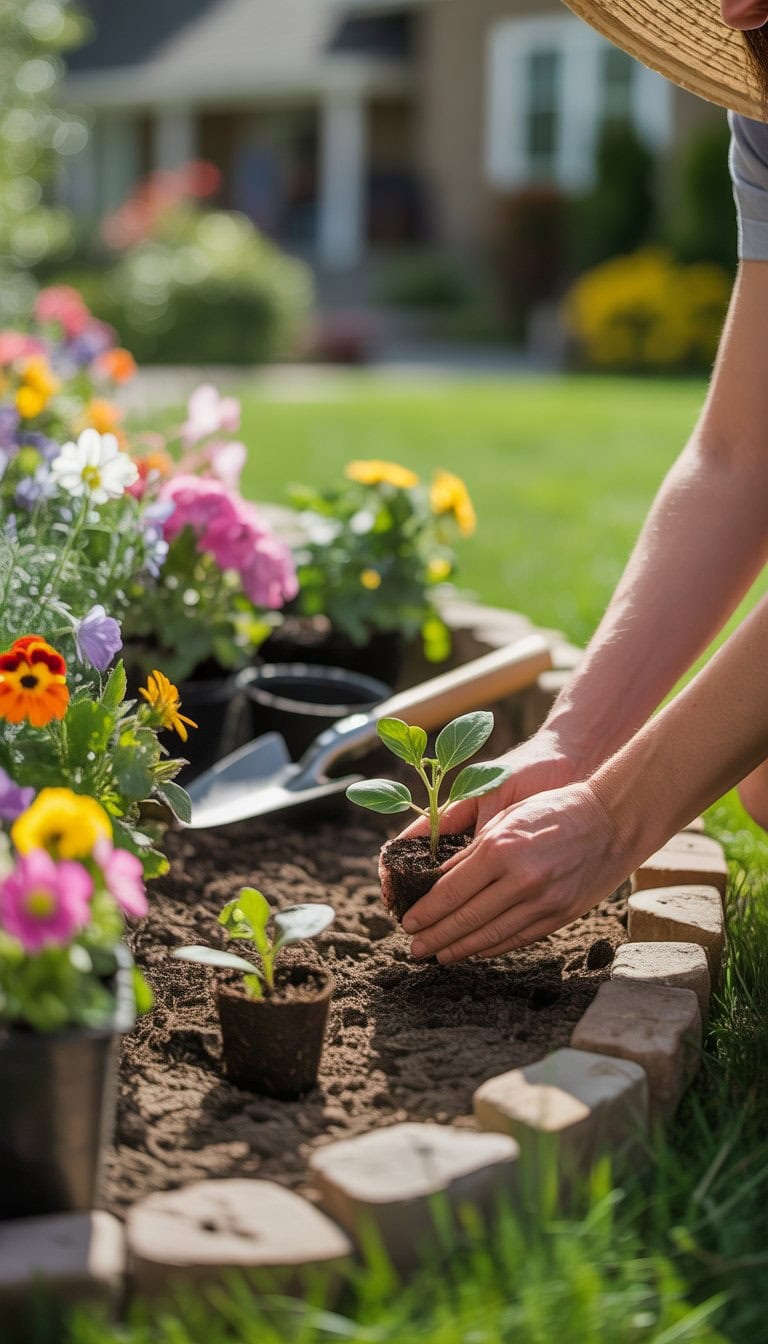
I love starting my front flower bed plants from seed because it saves me a lot of money. For just a few dollars, I can grow many seedlings instead of buying them one by one. This lets me fill more space with flowers.
I often use recycled containers and budget-friendly soil to keep my costs even lower. It feels great knowing I can start a pretty bed for less than $20 by following simple steps at home. See some helpful tips for budget-friendly seed starting.
With seeds, I get to choose exactly which plants I want, and I watch them grow from the very start. It makes the whole process more rewarding for me.
Arranging colorful annuals for seasonal change
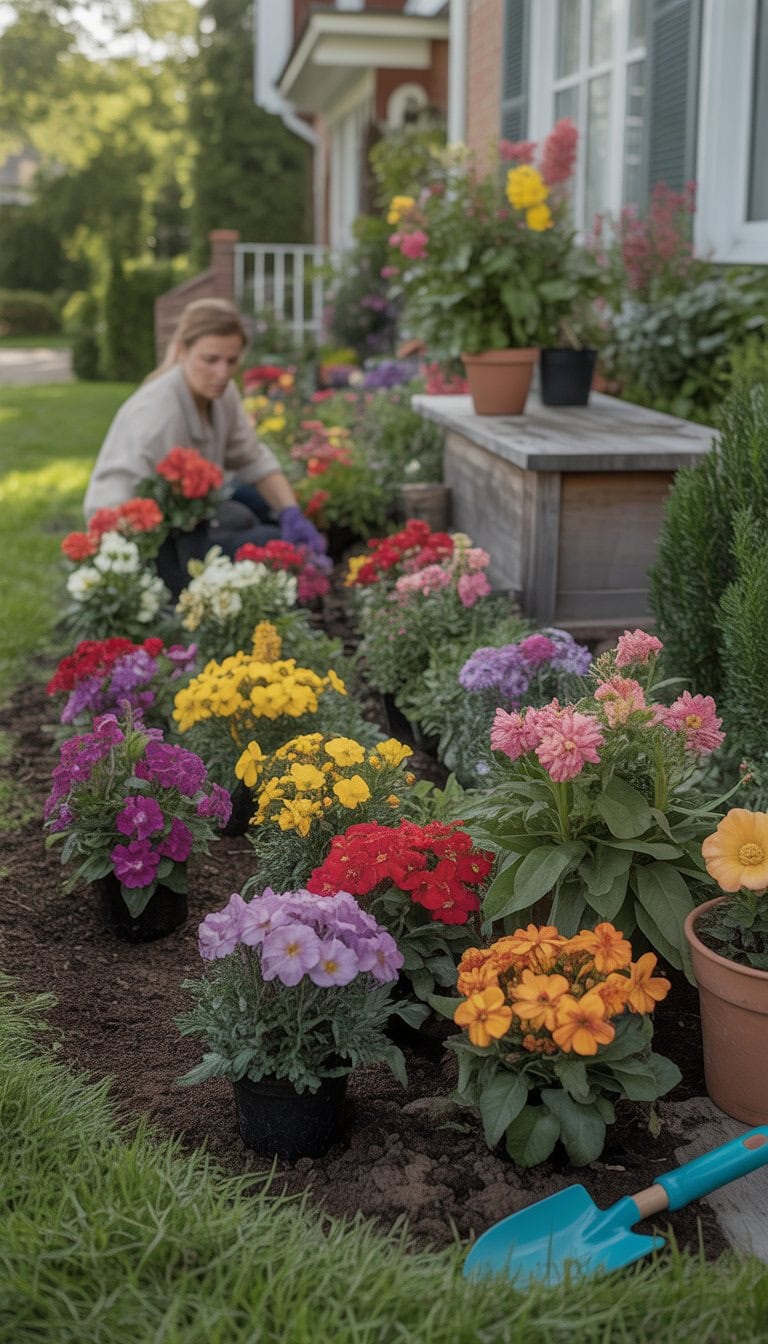
I like to switch up the look of my front flower beds by planting different annuals as the seasons change. In spring, I often pick cool colors like blue lobelia and soft pink petunias. These fresh blooms help wake up my yard after winter.
As summer rolls in, I swap some of my spring flowers for bold choices like marigolds and verbena. Their bright colors always stand out in the sunlight. I mix heights and textures to keep things interesting, sometimes adding coleus or dusty miller for a silver touch.
Trying new combinations each year keeps gardening fun for me. I enjoy seeing how the beds transform and come alive with color every few months.
Including plumerias for exotic flair
I like to plant plumerias in my front flower bed when I want to add something unique. The bold, fragrant blooms stand out right away and bring a tropical look to my yard. Their sculpted branches look good even when they are not flowering.
Plumerias pair well with smaller plants and groundcovers. Sometimes I add them near agave or succulents for a nice contrast of shapes and textures.
If I have a sunny spot with well-draining soil, plumerias grow strong and healthy. I water them regularly during summer but let the soil dry out between watering. Seeing those clusters of colorful flowers always brightens my entryway.
For landscape inspiration, I check out plumeria landscaping ideas online.
Designing a Welcoming Entryway
Nothing feels better than coming home to a front yard that lifts my mood and invites guests in. To get a beautiful entry, I focus on picking flower colors that go together and mixing plants with different shapes and heights.
Choosing a Cohesive Color Palette
When I pick out flowers, I start by looking at the color of my house and door. If my house is neutral, adding bright blooms like yellow marigolds or pink petunias really makes things pop. For homes with bold tones, I like to soften things with whites and blues.
I often group flowers by shade for a neat look. For example, all pinks, purples, and whites feel romantic, while reds, yellows, and oranges look lively. I also use green shrubs or grasses as a base, because they tie everything together.
Here’s a quick list of color ideas that work well together:
- Soft: pale blue, lavender, white
- Bold: red, orange, yellow
- Classic: pink, white, dark green
If I’m ever stuck, I’ll take inspiration from neighborhood gardens or check out online front yard flower bed ideas.
Balancing Plant Heights and Textures
Getting the right height mix is key for a flower bed that looks full and healthy. I always put the tallest plants—like hollyhocks or sunflowers—at the back if the bed sits against my house. Shorter blooms, like pansies or alyssum, go up front.
To keep beds interesting, I like to blend textures. This means using a mix of broad-leafed plants, soft ferns, and spiky ornamental grasses. A good mix keeps it from feeling flat.
Here’s how I layer for best results:
- Back: Tall flowers or small shrubs
- Middle: Medium perennials like coneflowers
- Front: Low groundcovers or trailing plants
If I’m looking for more design examples, I sometimes look up entryway garden ideas to see how the pros do it. This always sparks a few fresh ideas for plant pairing and arrangement.
Essential Maintenance Tips
Taking care of front flower beds helps them look healthy and boosts the beauty of my home. With a few good habits, I can keep my flowers thriving through every season.
Seasonal Care for Front Flower Beds
I always try to plan for each season, since weather changes can make a big difference to my plants. In early spring, I clear away old leaves and check for any winter damage. I prune dead branches and add fresh mulch, which keeps the soil moist and stops weeds from growing.
In the summer, I watch for signs of heat stress, like wilting. Adding or adjusting mulch makes it easier to keep the ground cool. I try to choose low-maintenance plants that can handle dry spells on their own, which saves me time and effort. In fall, I remove faded flowers and tidy up borders. This helps prevent pests from wintering over and keeps my yard tidy for next year.
Winter protection is simple. I use a layer of mulch or straw over my flower beds to insulate roots and help plants survive the cold.
Watering Strategies for Curb Appeal
A good watering routine means my front yard always looks refreshed. I prefer deep watering, so moisture reaches the roots instead of just wetting the surface. Deep watering is important because it encourages roots to grow down and makes plants stronger during hot, dry weather.
I usually water early in the morning, which means less is lost to evaporation, and leaves have time to dry out. For busy weeks, I use drip irrigation or soaker hoses, which keep water where it’s needed without waste. Mulch is also helpful for holding in moisture and stopping weeds from stealing water, as highlighted in tips from LawnStarter’s guide to landscaping ideas for your front yard.
If I see pooled water or yellow leaves, it’s a sign I might be watering too much. Adjusting my schedule helps avoid root rot and other problems.
Frequently Asked Questions
I love sharing what works best for creating beautiful, easy-to-care-for front flower beds. Whether you want all-season color or clever ways to add charm without spending too much, I’ve tried and tested tips that make a real difference.
What are some creative concepts for designing a low maintenance front flower bed?
I always go for drought-tolerant plants like Russian sage and lavender since they hold their own with little attention. Raised beds with natural stone borders save me from weeding and make watering simpler.
Layering mulch and using groupings of similar low-care plants means I spend less time trimming and more time enjoying the view. If you need more ideas, check out these front yard landscaping ideas for easy inspiration.
How do I choose plants for a full-sun front flower bed to ensure year-round blooming?
I pick plants that bloom in different seasons—like quick-fire hydrangeas for summer, Russian sage and black-eyed Susans for late summer to fall, and evergreen shrubs for winter interest. Native perennials are my favorite because they return each year, handle sun well, and need less care.
Mixing in groundcovers, tall stems, and flowering shrubs also keeps my beds looking lively whatever the month. For plenty of choices, these front yard flower bed ideas offer great suggestions.
Can you suggest ways to incorporate rocks into my front flower bed design?
I use natural stone borders to define my beds. Large flat stones can act as a little walkway, while smaller river rocks look great around plant bases and help with drainage.
If I want a focal point, I place a boulder or two near the center and plant low growers like catmint or creeping thyme around them. There are plenty of unique landscaping border ideas that can boost curb appeal while keeping things orderly.
What strategies can I use to keep my front flower bed budget-friendly without sacrificing charm?
I divide my perennials and swap plants with neighbors to save on costs. Planning my layout ahead stops me from overbuying.
Using mulch from local sources, choosing easy-care plants, and mixing in a few standout shrubs like white spirea gives high impact on a small budget. Flower beds can be both beautiful and affordable when I focus on hardy, reusable plants.
Could you share some tips on determining the ideal depth and width for a front house flower bed?
For most homes, I keep my beds about 2-4 feet deep, depending on how much space I have and the size of the plants I want. Up against the house, that’s deep enough for a nice mix without feeling crowded.
The width depends on my walkway—usually, I leave at least a foot between paths and beds so plants don’t spill over too much. This helps everything look neat and easy to trim.
Which types of flower bed layouts can maximize curb appeal for a front yard?
I love sweeping curves for a natural look, especially with raised beds along the walk or driveway. Layering taller plants in the back and low growers up front keeps my design looking polished and tidy.
Sometimes, I put a bold hydrangea or a cluster of spirea in the center as a visual anchor, with colorful perennials filling in around the edges. I also recommend mixing foliage textures and plant heights for extra interest. If you need more layout inspiration, browse these creative flower bed layouts.

